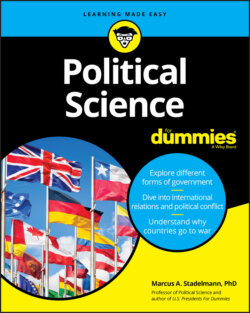Читать книгу Political Science For Dummies - Marcus A. Stadelmann - Страница 8
ОглавлениеIntroduction
As a professor of political science, some of the most frequently asked questions I receive from students include the following: Why study political science? Why should different forms of government and world politics matter to me? Why study political theory and learn about foreign cultures? Most students assume that political events occurring either at home or in faraway countries don’t impact their daily lives and are therefore not too concerned about them. Why would someone in Texas care about a new senator being elected in Oregon? Why would a college student living comfortably in the U.S. care about what’s happening in Central Asia? What is globalization, how does it impact us, and why care about it? Why read a book written by an old Greek guy who has been dead for thousands of years? Because learning these concepts helps define how people come together and the importance of being a citizen of the world.
By reading this book and becoming a student of political science, you’ll acquire the necessary tools to become familiar with, study, and hopefully become interested in both domestic and international political affairs. I hope that this political interest will then get you involved and encourage you to participate in politics.
Studying politics isn’t easy. Many factors shape it — individuals, such as leaders of political parties and countries; international organizations, such as the United Nations; domestic factors, such as political cultures and public opinion; and even disasters, such as the COVID-19 outbreak. Albert Einstein put it best almost a century ago when asked why men could discover the structure of the atom but were unable to keep it from destroying the world, stating: “This is simple, my friend; it is because politics is more difficult than physics.”
About This Book
This book is intended as an introduction to the study of politics and political science. I assume no prior knowledge of the political process or the discipline of political science. While writing this book, I’ve strived to be nonpartisan, meaning that I didn’t write with any type of political ideology in mind. I also didn’t attempt to push certain political ideas and concepts while ignoring others.
One of the purposes of this book is for readers to come to their own conclusions and become more informed citizens and participate in not just debates on politics but in the political process. With politics being the process of making decisions for the public, it affects us all. Therefore, citizens need to be educated on the issues of the day and must be willing to participate in politics.
Whenever the text discusses certain concepts, such as federalism, I provide not only a definition of the term but also real-life examples of the concept. I show how it’s being applied in countries and how it works. I draw many examples from democracies, mostly located in Europe, but I also focus on the rest of the world, especially in the section on international organizations, globalization, and warfare.
I designed this book to provide a solid foundation on the discipline of political science. It will prove to be helpful whether you’re studying political science, writing a paper, or reading to expand your knowledge. I tried to make the book entertaining by including little-known tidbits on many topics. So whether you’re a political science student or just someone interested in the discipline, this book is for you. My hope is that this book will prove one point: Politics matters, and everyone needs to get involved in it.
Conventions Used in This Book
The information in some chapters is relevant to more than just that chapter. When this is the case, I include cross-references to these chapters by chapter number. For example, I discuss the U.S. Constitution in Chapter 5. However, I also analyze specific constitutional powers of the American legislature and executive in Chapter 6.
Icons Used in This Book
As you read and enjoy this book, you’ll see two different icons that alert you to specific aspects related to political science, its subfields, and major writers and their works.
This icon points out important information you should be aware of as you read the section, the chapter, or the book. This icon covers only the most important events, people, and issues.
Historical information often case-specific, including treaties, important battles, strategic doctrines, and other relevant material or events have this icon beside them. This information isn’t necessary for grasping certain concepts but is required for a political scientist in the making.
Beyond the Book
In addition to what you’re reading right now, this book comes with a free access-anywhere Cheat Sheet that includes a list of political scientists and their major works as well as a handy bank of major political science concepts. To get this Cheat Sheet, simply go to www.dummies.com and type “Political Science For Dummies Cheat Sheet” in the Search box.
Where to Go from Here
Feel free to start with any chapter in the book that interests you. Keep in mind that all the chapters are nonlinear, so you can start with any topic in any chapter. Happy reading!
